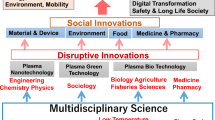Abstract
The in situ-monitoring of a solid synthesis was realised by electroacoustic and acoustic attenuation spectroscopy. These techniques were applied to track the crystal growth of alumina precursor nanoparticles used as model compound. A commercially available set-up with a circular flow detector cell for joint electroacoustic and attenuation measurements was used. Course of zeta potential as well as particle growth was measured during continuous hydrolysis of dry Al-sec-butoxide in isopropanol. Zeta potential shows minima and maxima with increasing water amount, whereas particles start to grow significantly after a defined time of operation. In some experiments the synthesis was stopped ahead of time and the formed solids were additionally studied ex situ by characterisation methods such as solid-state NMR or transmission electron microscopy. Measured ultrasound data can be correlated to elemental processes during particle formation. First experiments on monitoring of synthesis scale-up show potential for future application of this technique.












Similar content being viewed by others
References
Weckhuysen BM (2003) Phys Chem Chem Phys 5:4351
Palmqvist AEC (2003) Curr Opin Colloid Interface Sci 8:145
Arora AK, Tata BVR (1998) Adv Colloid Interface Sci 78:49
Campanati M, Fornasari G, Vaccari A (2003) Catal Today 77:299
Holmberg K (2004) J Colloid Interface Sci 274:355
Patarin J, Lebeau B, Zana R (2002) Curr Opin Colloid Interface Sci 7:107
Fricke R, Kosslick H, Lischke G, Richter M (2000) Chem Rev 100:2303
Hench LL, West JK (1990) Chem Rev 90:33
O’Brien RW, Jones A, Rowlands WN (2003) Colloids Surf A Physicochem Eng Asp 218:89
Dukhin AS, Goetz PJ (2001) Colloid Surf 192:267
Tebbutt JS, Marshall T, Challis RE (1999) Electron Lett 35:90
Babick F, Ripperger S (2004) Chem Ing Tech 76:30
Steinborn G, Wäsche R (2007) Chem Ing Tech 79:257
Herrmann R, Schwieger W, Scharf O, Stenzel C, Toufar H, Schmachtl M, Ziberi B, Grill W (2005) Micropor Mesopor Mater 80:1
Lyall E, Mougin P, Wilkinson D, Roberts KJ (2004) Ind Eng Chem Res 43:4947
Gron H, Mougin P, Thomas A, White G, Wilkinson D, Hammond RB, Lai X, Roberts KJ (2003) Ind Eng Chem Res 42:4888
Hunter RJ (1981) Zeta potential in colloid science. Academic Press, London
Acknowledgments
The authors like to thank Dr. M.-M. Pohl for investigating the samples by TEM, Prof. M. Jäger (BAM) for the 27Al-MAS-NMR measurements and J. Kubias for experimental assistance. Financial funding by BMBF (FKZ 03X2004) and Senate of Berlin is gratefully acknowledged.
Author information
Authors and Affiliations
Corresponding author
Rights and permissions
About this article
Cite this article
Armbruster, U., Bräunig, R., Balosu, P. et al. Electroacoustic and Acoustic Attenuation Spectroscopy as New Tools for In Situ-Monitoring of Metal Oxide Precursor Preparation in Liquid Phase. Top Catal 52, 1342–1349 (2009). https://doi.org/10.1007/s11244-009-9308-z
Published:
Issue Date:
DOI: https://doi.org/10.1007/s11244-009-9308-z




